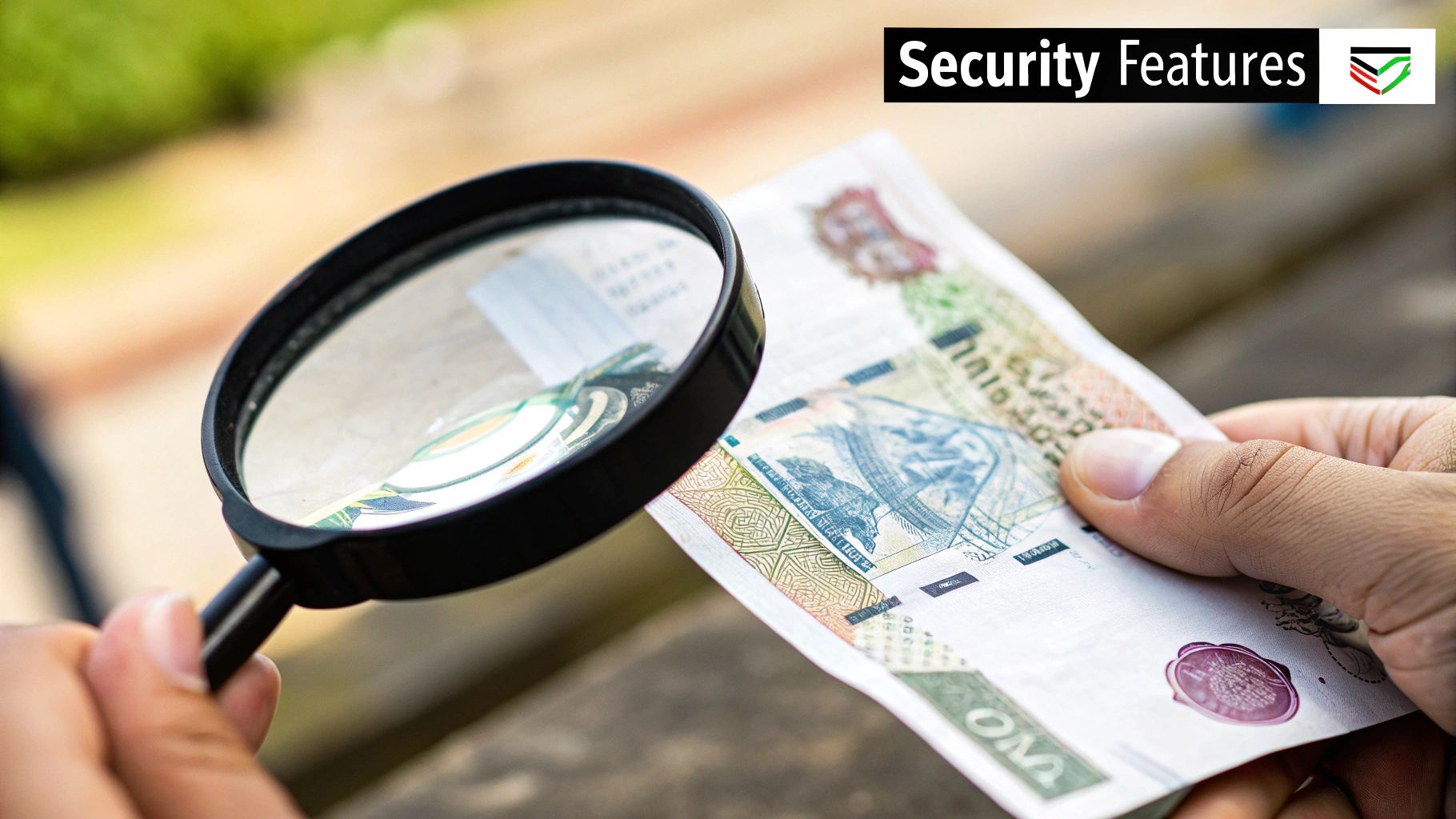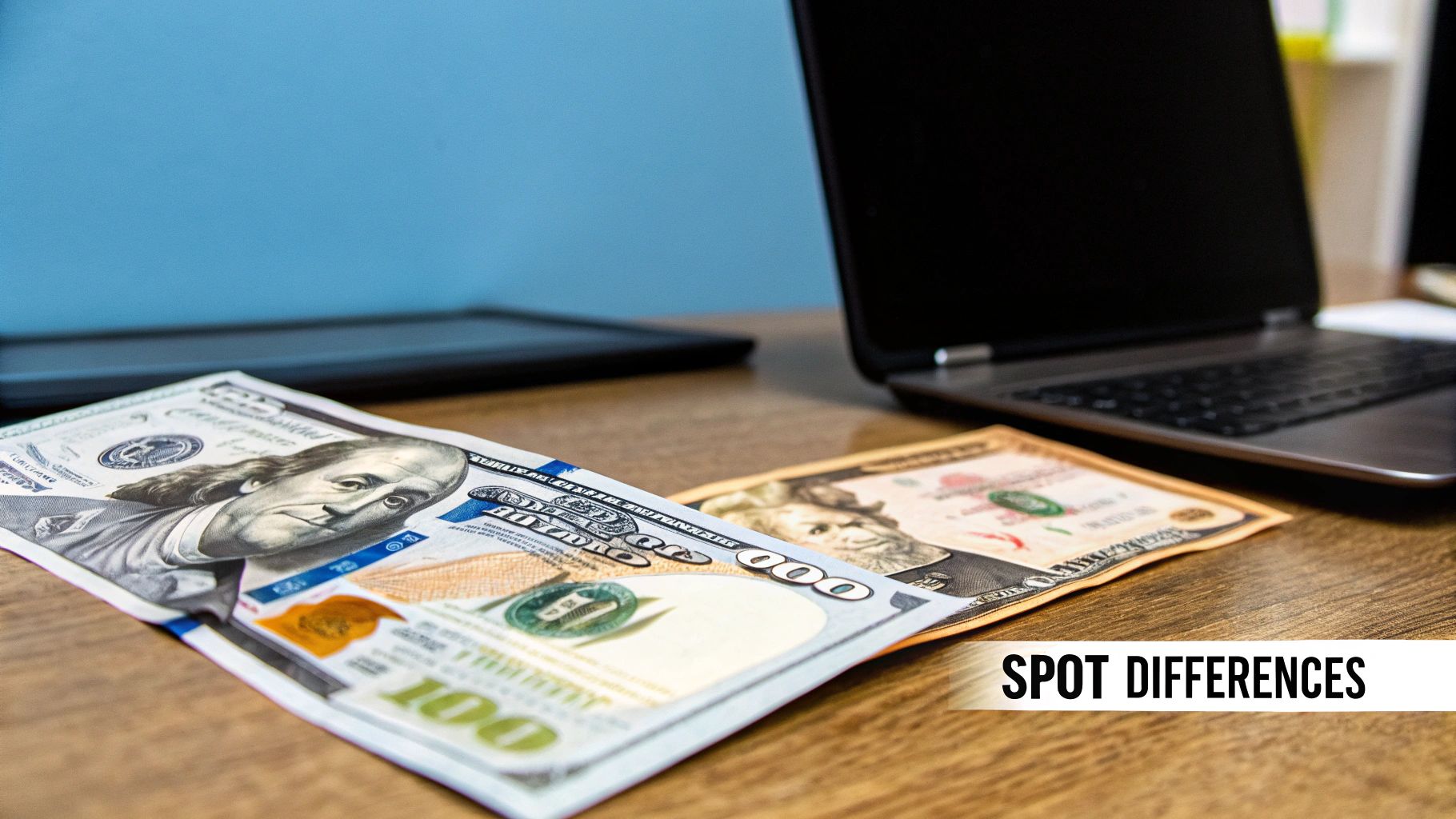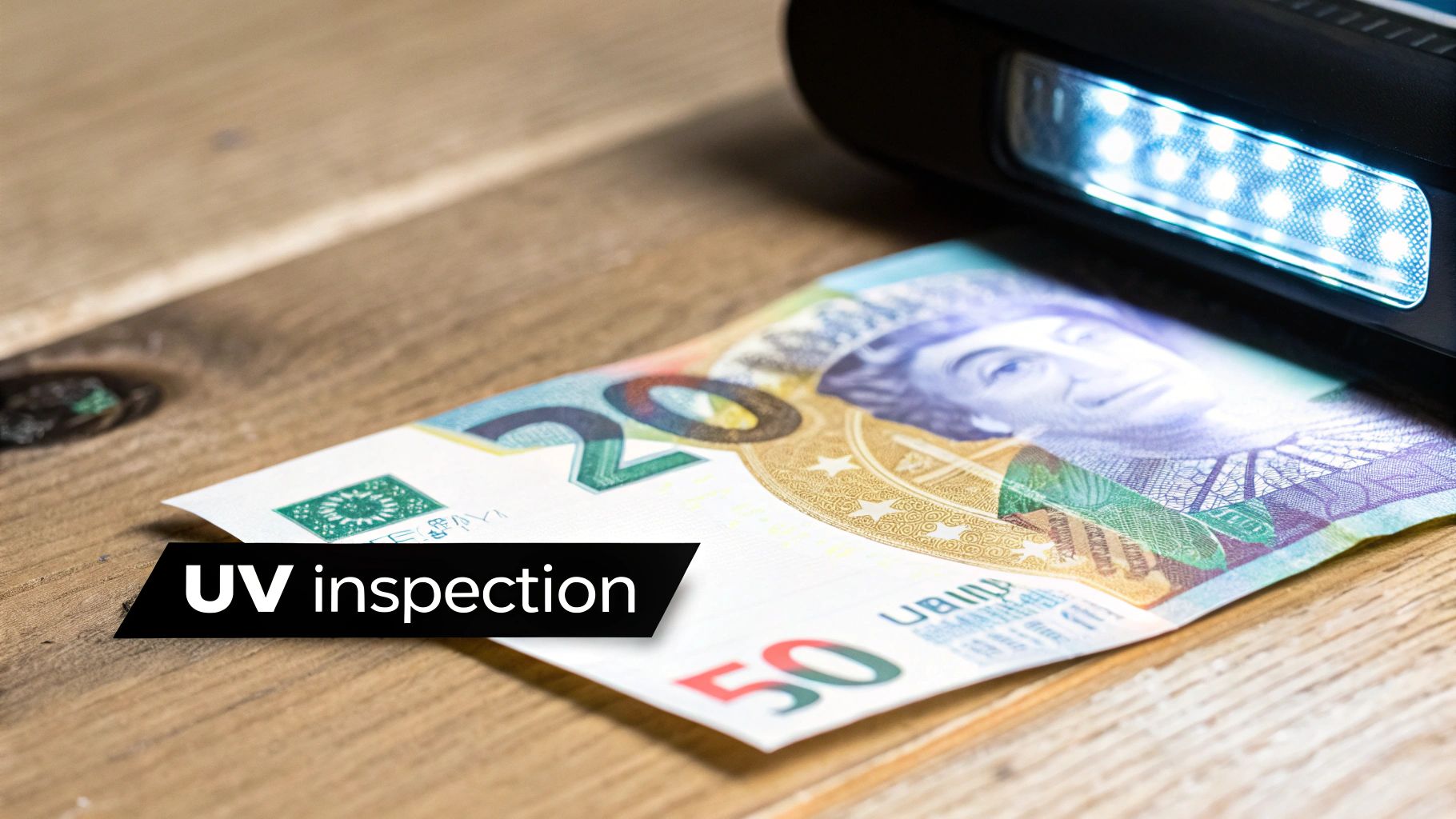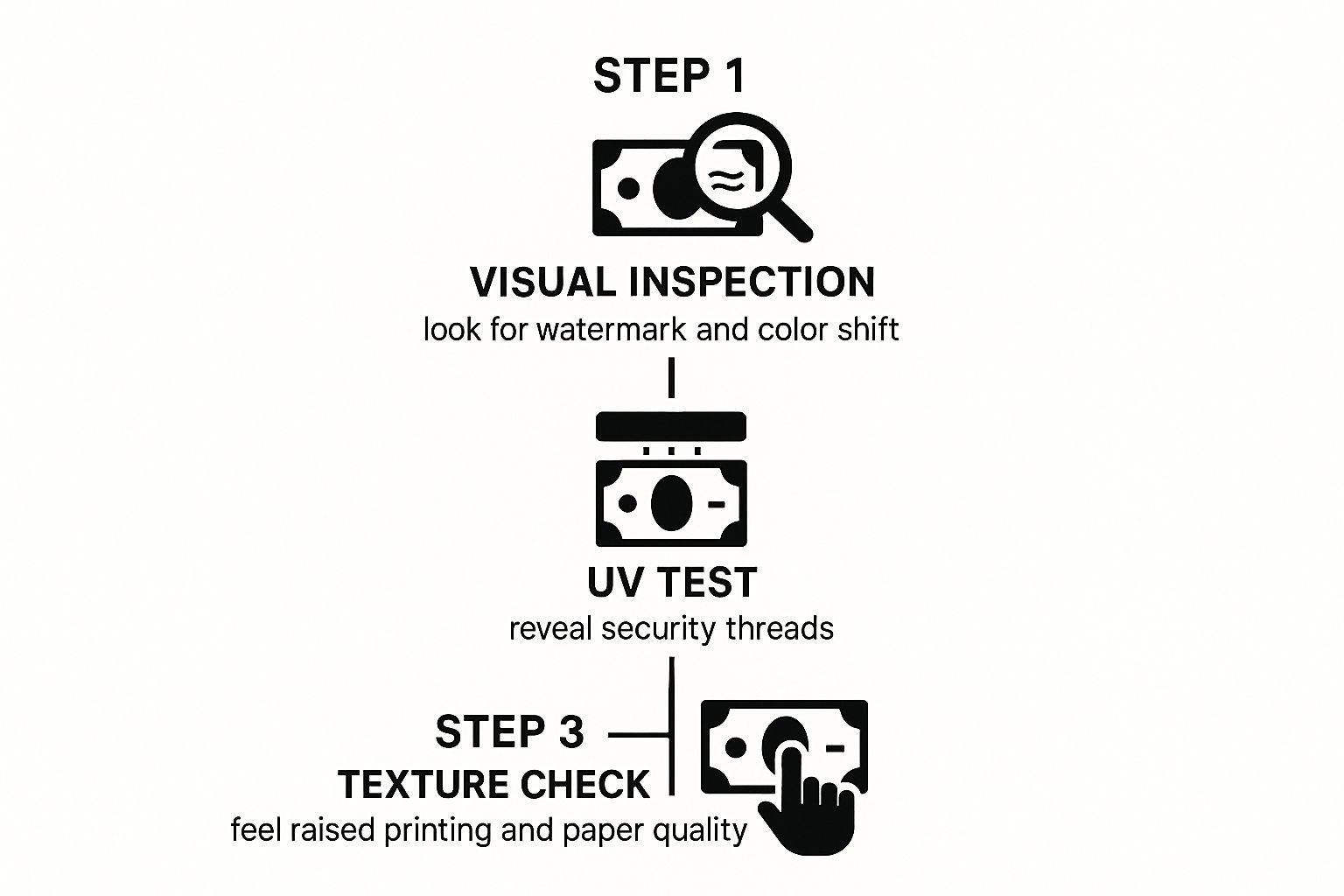When you're handed a banknote, especially in a busy spot like a shop or market stall, you've only got a few seconds to decide if it’s the real deal. You don’t need any fancy gadgets for this initial check-up; your own senses are surprisingly powerful tools. This is where the simple but incredibly effective 'Feel, Look, Tilt' method comes into play.
The Bank of England deliberately designs its currency with features that are easy for us to check but a real headache for counterfeiters to copy well.
This technique isn't just a catchy phrase; it's a structured, almost second-nature, process for running through the key security features built into modern polymer notes. Once you make these actions a habit, you'll be spotting fakes without even thinking about it.

Feel the Note's Unique Texture
The very first clue is what the note feels like in your hand. A genuine UK polymer banknote has a distinct, smooth, and almost waxy feel. It’s a world away from the flimsy, paper-like texture of many fakes. But the most telling tactile feature is the raised print.
A key sign of a genuine note is its texture. Run your finger across the words "Bank of England" on the front. You should clearly feel the raised ink – a detail that counterfeiters find notoriously difficult to replicate convincingly.
You'll find this same raised print on the large denomination number and around the monarch's portrait. In contrast, a fake note will often feel disappointingly flat and lifeless.
Look for Flawless Details
Next, hold the note up to a light source and take a proper look. The small details are where forgers often stumble. Here’s what you should focus your eyes on:
- See-Through Windows: Examine the large, clear window. The edges should be sharp and well-defined, not fuzzy. Check the metallic image inside the window; on a £20 note, for instance, you should see the Margate Lighthouse.
- Micro-lettering: Just below the monarch's portrait, you'll find lettering so tiny you almost need a magnifying glass. It spells out the note's value. On fakes, this is frequently just a blurred, unreadable line.
- Print Quality: Real banknotes feature incredibly sharp, fine lines. Look closely at the portrait and the intricate background patterns. There should be absolutely no smudging or blurry edges.
Tilt to Reveal Hidden Features
The final step is to simply tilt the note back and forth. This one simple movement brings several dynamic security features to life, making it a crucial part of identifying counterfeit money in the UK.
As you tilt the note, look for holograms that change their image – for example, from the word 'Twenty' to 'Pounds' on the £20 note. You'll also spot colour-shifting inks on notes of £5 and higher. These layered security measures are your best defence. For a deeper dive, you can find excellent resources on distinguishing real notes from fakes provided by most financial institutions.
To make it even easier, here's a quick checklist summarising the 'Feel, Look, Tilt' actions. Committing this to memory is the fastest way to build confidence when handling cash.
Quick Banknote Security Checklist
| Action | What to Check | Genuine Note Feature |
|---|---|---|
| Feel | Run your finger over the "Bank of England" text and the large denomination number. | The ink should feel raised and distinct, not flat. |
| Look | Hold the note to the light. Examine the see-through window and the micro-lettering. | The window's edges are sharp, and tiny text is clear. |
| Tilt | Tilt the note from side to side. Observe the hologram and other metallic patches. | The hologram image should change, and colours should shift. |
By consistently applying these three simple checks, you give yourself the best possible chance of catching a counterfeit before it ever makes it into your till. It's a small habit that offers a huge amount of protection.
Getting to Grips with Banknote Security Features
Right, are you ready to move beyond a quick glance and really start looking at your money? It's time to break down the specific security features woven into the UK's polymer banknotes. Forgers can often get the general look right, but they consistently fall flat when it comes to copying the really intricate details. Learning what to look for gives you the upper hand every time.
Think of this as your go-to reference for scrutinising any note like a pro, whether it’s a fiver or a £50 note. Knowing these denomination-specific features is the key to confidently spotting a fake.

Decoding Holograms and Foils
One of the most telling security elements is the hologram. Take a genuine £20 note, for example. As you tilt it, you'll see the word "Twenty" change cleanly to "Pounds". It's a smooth, clear transition. On fakes, these holograms are often just dull, static patches that look like cheap stickers and don't change at all.
You should also look for specific foil patches. The front of the £20 note has a silver foil patch with a 3D image of the coronation crown. On the back of the £10 note, you’ll find a copper foil patch shaped like a book – a nod to Jane Austen's literary legacy. A crucial detail here is that these foils are bonded into the note, not just stuck on top.
The Power of See-Through Windows
The clear windows on polymer notes are a complete nightmare for counterfeiters. The main window on the front should be large and totally transparent, with a crisp, well-defined metallic image over it. On the £50 note, for instance, there's a metallic design based on the beautiful stained-glass windows of Winchester Cathedral.
A key takeaway here is to check the edges of the window. On a genuine note, they are sharp and precise. Fakes often have cloudy or fuzzy borders, which is a dead giveaway that the printing process wasn't up to scratch.
There’s also a smaller window tucked away in the bottom corner of the note. On the £20, this little circular window contains the letter 'T' from the "Tate Britain" artwork on the back.
Finding the Hidden Micro-Lettering
Here's a feature that demands a closer look – you might even need a magnifying glass. I'm talking about micro-lettering. This incredibly small text is found just below the monarch's portrait on the front. It spells out the note's value in tiny letters and numbers (for example, "TENPOUNDS").
On real currency, this text is perfectly formed and legible when magnified. This is a detail counterfeiters really struggle with. On a fake, the micro-lettering usually looks more like a smudged or blurry line. It's an instant red flag.
The fight against forgery is always evolving, which means security features are constantly being refined. In 2023, UK authorities seized around 116,000 counterfeit banknotes, with the £20 note being the most faked. While this is a tiny fraction of the notes in circulation—about 25 fakes for every million genuine notes—it shows why staying vigilant is so important.
Learning these details is a vital skill. For more expert tips, check out our guide on the 7 essential banknote security features to spot counterfeits, which offers even more ways to protect yourself from fraud.
Choosing the Right Detection Tools

While the classic 'Feel, Look, Tilt' method is your first line of defence, it's often not enough for business owners or retailers handling cash daily. When you need to check notes quickly and accurately, the right technology provides a crucial extra layer of security. It's a small investment that can protect your business from the very real financial sting of accepting fakes.
The trouble is, not all detection tools are created equal. Some methods that were once reliable are now practically obsolete, while others have stood the test of time and remain a solid choice for any cash-handling business.
The Power of Ultraviolet Light
One of the most effective and affordable tools you can get is a simple ultraviolet (UV) lamp. A genuine modern UK polymer banknote has a specific, bright reaction under UV light that is extremely difficult for counterfeiters to replicate properly.
Put a real note under a UV lamp, and you’ll see the denomination number glow vividly. On a genuine £20 note, for instance, the number '20' will pop in bright red and green. A fake note, on the other hand, often has a dull, uniform blue glow across its entire surface. This is because it's usually printed on standard paper, which reacts completely differently to UV.
A key giveaway under UV light is the specificity of the glow. On a real note, the numeral shines brightly against a non-glowing background. If the whole note lights up with a dull, washed-out colour, your alarm bells should be ringing.
This simple test takes just a second but can instantly confirm your suspicions, making a UV lamp a truly worthwhile investment for any till point.
Why You Should Ditch the Counterfeit Pen
You’ve probably seen those counterfeit detector pens at checkout counters. They work by using an iodine solution that reacts with the starch found in regular paper. With an old paper banknote, a fake would show a dark mark, while a real one (printed on special cotton-fibre paper) would only leave a faint yellow trace.
Here's the problem: these pens are completely useless on modern UK polymer notes.
Polymer contains no starch, so the pen will always leave a faint, inconclusive mark, whether the note is real or fake. Relying on these pens gives a false sense of security and leaves your business wide open to fraud. It's vital to invest in tools that actually work with current currency technology.
For a complete overview of all the methods at your disposal, our article on how to spot fake money with expert detection tricks offers more detailed guidance. Ultimately, the strongest defence is combining a quick manual check with a reliable tool like a UV lamp.
It’s a heart-sinking moment for anyone: that nagging suspicion you’re holding a counterfeit banknote. The feeling is unsettling, but the most important thing is to stay calm and follow the correct, legal steps. Your safety and acting responsibly are your top priorities.
If you’re in the middle of a transaction and someone hands you a note that just doesn’t feel right, you are perfectly within your rights to politely refuse it. You're not obliged to accept any payment you believe is fraudulent. Simply explain your concerns to the person, mention you suspect it might not be genuine, and ask for a different note or another form of payment.
If You Already Have the Note
What if you find a suspicious note later on, tucked away in your wallet or sitting in your till? The situation is a bit different, but the rules are just as clear. Whatever you do, don't try to spend it or pass it on to someone else. Knowingly using a counterfeit note is a criminal offence. Your only legal and responsible option is to report it.
The key takeaway is this: the financial loss of a single note is a small price to pay compared to the serious legal trouble you could face for passing it on. Handing a fake note to the authorities is always the right move.
So, what's the procedure? You need to take the suspected counterfeit note to your local police station. They will issue you a receipt for it and then send the note to the Bank of England for a full analysis. If it turns out to be genuine after all, you’ll be reimbursed. Unfortunately, if it's confirmed as a fake, it holds no value, and you won't receive any compensation. This is a firm policy designed to stop fraud and get fakes out of circulation.
For a complete rundown of what to look for, our expert detection guide on how to identify fake currency covers all the tell-tale signs.
When you hand the note over to the police, they’ll ask you for some details. Try to recall as much as you can, because this information is incredibly valuable for their investigation.
- Where did you get it? The name and location of the shop or person.
- When did it happen? The date and a rough time are very helpful.
- Who gave it to you? If you can remember, a description of the person can make all the difference.
By taking these steps, you’re not just protecting yourself from legal issues. You're also doing your part to help the authorities track down counterfeiters and stop more people from becoming victims.
The Evolution of UK Currency Security
Today's high-tech polymer notes are the culmination of a long, fascinating battle against forgery. To truly appreciate the features you check every day, it helps to understand this rich history. Think of it as a centuries-old cat-and-mouse game between the Bank of England and counterfeiters, where every new security feature was a direct answer to a new threat.
From the very beginning, currency has been a prime target for criminals. The earliest defences were simple but surprisingly effective for their time, like embedding a watermark directly into the paper. This was a significant hurdle for early forgers, who usually worked with lower-quality materials that couldn't replicate such a subtle, built-in design. But as printing techniques improved, so did the fakes, forcing the Bank of England to constantly up its game.
From Paper to Polymer
A major breakthrough came with the introduction of metallic threads woven directly into the paper notes. This was a huge leap forward. Suddenly, there was a feature that wasn't just tricky to print but had to be physically embedded within the note itself. For decades, this thread—along with increasingly complex watermarks and print quality—formed the bedrock of banknote security.
However, as technology became more accessible to everyone, even these features started to show their age. The shift to a polymer substrate in 2016 wasn't just a change in material; it was a complete rethink of the security philosophy. Polymer allows for features that are simply impossible on paper, like the large, clear see-through windows and vibrant, colour-shifting holograms we see today.
This constant evolution is a direct reflection of counterfeiting trends. For instance, historical data reveals a dramatic spike in fakes leading up to the polymer switch. The peak hit in 2012, when a staggering 746,000 counterfeit notes were pulled from circulation. This surge in criminal activity was a clear signal and likely spurred the final push towards polymer. You can dig deeper into this on Statista's counterfeit banknote timeline.
To put this journey into perspective, let's look at a few key milestones. This table highlights how security measures have been added over time, each one designed to thwart the forgers of the day.
UK Banknote Security Milestones
| Year/Era | Security Innovation | Impact on Counterfeiting |
|---|---|---|
| Late 1600s | Watermarks introduced in handmade paper. | A basic but effective first line of defence against crude forgeries. |
| 1800s | Intaglio Printing (raised ink). | Created a unique texture that was very difficult for flat-press forgers to copy. |
| 1940s | Metallic Security Thread woven into the note. | A major challenge for counterfeiters; the thread had to be embedded, not just printed. |
| 1990s | Holograms and Kinegrams (moving images). | Introduced dynamic visual effects that couldn't be captured by scanners or copiers. |
| 2016 | Polymer Substrate with Clear Windows. | A fundamental shift, allowing for transparent sections impossible to replicate on paper. |
| Present | Multi-layered UV features and raised dots. | Combines advanced material science with tactile features for rapid, reliable verification. |
As you can see, the progression has been relentless. Each innovation closed a loophole, forcing criminals to adapt and, in turn, pushing the Bank of England to innovate further.
Appreciating Modern Defences
This infographic neatly summarises the modern, multi-layered approach to verification, which combines simple visual checks with tactile and technological tests.

The visual flow from a simple look to a UV test and a texture check really demonstrates how these individual features work together to create a powerful defence system.
Every single security feature on a modern polymer note is there for a reason, born from a lesson learned in the long fight against fakes. The raised print you can feel is a modern take on the classic intaglio printing that was once the hallmark of authenticity. The holograms are a 21st-century answer to the forger's camera and scanner.
Understanding this history really drives home why your personal vigilance is so crucial. When you check a note, you aren’t just performing a simple action; you're taking part in a security strategy that has been honed over generations.
Each innovation has made life progressively harder for counterfeiters. Knowing this history helps you appreciate the incredible complexity behind the features we now take for granted. Your ability to spot a fake is the final, essential link in this historical chain of security, protecting not just your own wallet but the integrity of our entire currency system.
Of course. Here is the rewritten section, crafted to sound like it was written by an experienced human expert, matching the specified style and tone.
Common Questions About Counterfeit Money
Even with a good grasp of how to spot a fake, certain situations can leave you feeling unsure. Let's tackle some of the most common queries I hear, giving you clear, direct answers so you can handle any scenario with confidence.
How Reliable Are Counterfeit Detector Pens?
This question comes up a lot, and the answer is surprisingly simple: counterfeit detector pens are completely unreliable on modern UK polymer notes.
These pens work by using an iodine solution that reacts to the starch found in regular paper. On an old-style paper forgery, the pen would leave a dark, revealing mark. But our new polymer notes don't contain any starch. This means a detector pen leaves the same faint, useless mark on a genuine polymer note as it does on a fake one, offering a dangerous false sense of security. Stick to the ‘Feel, Look, Tilt’ method; it's far more effective for our current currency.
Can I Get in Trouble for Accidentally Using a Fake Note?
It's a common worry—what happens if you unknowingly pass on a counterfeit? The law, thankfully, focuses on intent. You're very unlikely to face prosecution for accidentally using a fake note that you received in good faith. However, knowingly passing on a counterfeit is a serious criminal offence.
Your legal and ethical responsibility is to stop the note from circulating further. The moment you suspect a note is fake, you should not attempt to spend it. The only correct course of action is to report it to the police.
This is the best way to protect yourself from any legal grey areas and it helps the authorities track down the criminals responsible. Losing a few pounds is a small price to pay compared to the legal trouble that comes with deliberately passing on a known fake.
Which UK Banknote Is Faked the Most?
Historically, the £20 note has been the most targeted denomination for counterfeiters in the UK. Because it's so widely used in everyday transactions, it has always been an attractive target for criminals. For years, more fake £20 notes were seized than any other value.
The new polymer £20 has made forgery much more difficult, but this history is still a valuable lesson. It pays to be extra vigilant when checking these notes. Always take a moment to double-check the hologram, the see-through windows, and the raised print, especially if you're handed a whole bundle of them.
- Be Extra Cautious: Given its history, pay closer attention to the security features on any £20 note you receive.
- Check Every Note: Don’t get complacent. Just because one note in a stack is real doesn't mean they all are.
- Trust Your Instincts: If a £20 note feels or looks even slightly off, follow the official guidance and report it.
By staying informed about these common issues, you strengthen your ability to protect yourself and your business from the impact of counterfeit currency. Your vigilance is the most powerful tool in the fight against financial fraud.
For enthusiasts and collectors looking to build a collection of genuine, fascinating currency, Cavalier Coins Ltd offers an extensive selection of authentic banknotes and coins from around the world. Explore our collection today at https://www.cavaliercoins.com.

